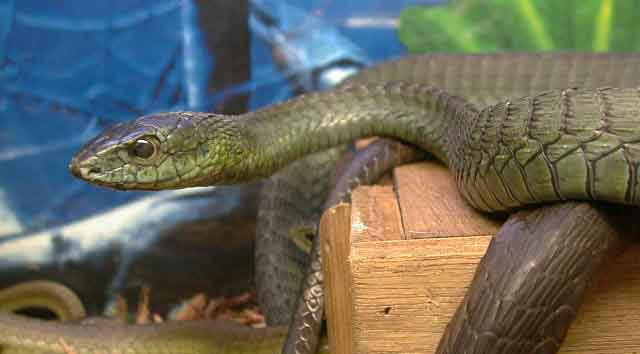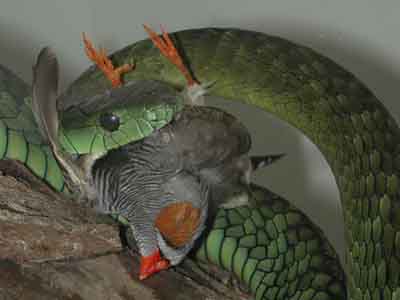
Introduction
This website explains some of the aspects of the chemistry of snake venom, antivenin (antivenom), how toxicity is measured and the application of snake venom in modern medicine.
Most snakes are non-venomous and kill their prey by constriction (suffocation by slowly tightening around their prey). The remaining species of snakes are venomous and inject venom into their prey using hollow or grooved fangs. A snake will strike or bite in order to kill or paralyse its prey or sometimes they will strike as a defensive mechanism, to scare off attackers. Not all snakebites will be envenomous, sometimes a snake will bite only in self-defence and does not inject venom into its assailant.

A picture of an eyelash viper striking, taken from http://innovol.sibs.strath.ac.uk
There are three types of venomous snakes: -
Opisthoglyph: These are the rear-fanged snakes The fangs are enlarged rear teeth with a 'groove' that venom flows down while they swallow their prey. They are mostly harmless or mildly venomous but there are two major exceptions. The Boomslang (Dispholidus typus) and the Twig snake (Thelotornis kirtlandi) both of which have killed humans.

This image of a boomslang was taken from http://www.coastalreptiles.com
Proteroglyphs: These are the fixed front fang snakes. These snakes have small non-movable front fangs. When they bite they hang on and 'chew' to envenomate the prey. Obvious examples of this type of snake are the cobras (Naja), kraits (Bungarus), mambas (Dendroaspis), and coral (Micrurus) snakes. These are some of the deadliest snakes in the world.

This image of a Jameson's mamba eating a bird was taken from http://www.coastalreptiles.com
Solenoglyph: These snakes have movable front fangs. The fangs fold back into the mouth until they are needed. This is what makes these snakes difficult to handle. They can grab on to your hand like a Proteroglyphs would but they can also open their mouth almost 180 degrees with the fangs extended straight out. This enables them to strike their prey more easily because it is more of a stabbing action than a bite. Examples include rattlesnakes (Crotalus), eyelash vipers (Bothriechis), gaboon vipers (Bitis), and copperheads (Agkistrodon)
